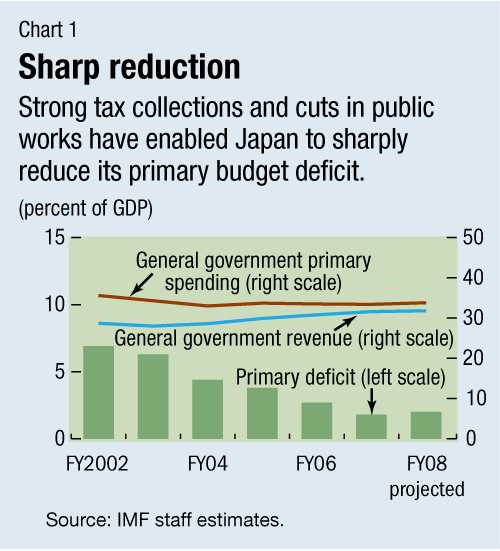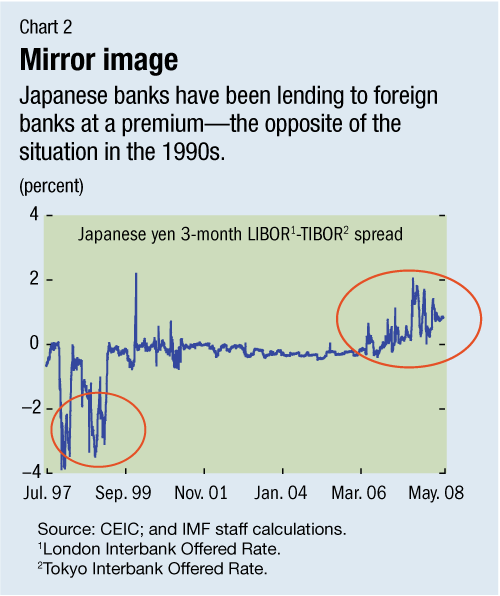
Typical street scene in Santa Ana, El Salvador. (Photo: iStock)
IMF Survey: Japan's Economy Is Slowing, But Soft Landing Expected
July 29, 2008
- Banking sector has withstood global financial market wildfires
- Further fiscal consolidation will likely require revenue measures
- Steps taken to improve disclosure in financial system
Japan's economy has shown resilience to recent external shocks but is nonetheless slowing, the IMF says in its latest annual economic review of the country.

Vehicles for export in Tokyo, Japan, where activity is being aided by strong exports to emerging markets (photo: Toshifumi Kitamura/AFP/ Getty Images)
ANNUAL ECONOMIC HEALTH CHECK
In its yearly Article IV consultation with Japan, the IMF says that the banking sector has withstood the worst of the global financial market wildfires that have swept across the globe in the past 12 months, and the economy has shown resilience to surging commodity prices. While consumer and business confidence have declined, activity remained robust through the first quarter of 2008, aided by strong exports to emerging markets.
Timely liquidity provisions by the Bank of Japan (BoJ) and the financial sector's limited subprime exposure also helped to cushion the effects of global financial pressures.
Most recently, however, activity appears to be slowing in line with decelerating global growth and the deteriorating terms of trade. The IMF projects GDP growth to moderate to about 1 ½ percent in 2008-2009, reflecting weaker business investment and private consumption. Such growth is slightly less than potential, and below the 2 percent average during 2003-2007.
Headline inflation has climbed in recent months to 2 percent, but underlying inflation (stripped of food and fuel prices) is still about zero and wages remain sluggish.
Soft landing
Although a soft landing is foreseen, the growth outlook remains subject to considerable uncertainty, particularly surrounding the depth of the U.S. slowdown. Highly volatile commodity prices also make inflation difficult to project. Nonetheless, with the downturn expected to be modest, and inflation still contained, the IMF's view is that current policy settings are broadly appropriate.
In particular, monetary policy should remain accommodative; fiscal policy should remain focused on medium-term challenges; and continued efforts should be made to strengthen the financial sector. There is also a need to reinvigorate structural reforms.
Given current uncertainties, monetary policy is understandably in a "wait and see" mode, with the BoJ keeping policy rates on hold pending a better sense of whether downside risks to growth activity or upside risks to inflation will prevail. The process of normalizing interest rates that began in 2006 could then resume once downside risks to growth recede. Meanwhile, the BoJ has enhanced its communication regarding the outlook which should help guide inflation expectations.
Longer-term horizon
Fiscal policy should consider a longer-term horizon in light of the need to bring down high public debt and make room for aging-related spending. Strong tax collections and cuts in public works have enabled the primary deficit (excluding social security) to be reduced sharply in recent years (see Chart 1).

Moreover, the authorities plan to eliminate the primary deficit altogether by FY2011. However, a more ambitious adjustment may be required to put the public debt ratio firmly on a downward path. This will not be easy, given that much of the room for expenditure reductions has already been utilized. Further fiscal consolidation will surely require revenue measures, including raising the consumption tax.
The government's intention to increase its contribution to the basic pension during FY2009 provides an opportunity to raise taxes. The public may be more receptive to a higher consumption tax rate if linked to the need to fund social security. The government's plan to end earmarking of gasoline tax revenue for road-related spending from next year is also welcome.
Yen appreciation
The financial developments over the past year have been accompanied by an appreciation of the yen—by around 10 percent in real effective terms. Staff analysis suggests that the yen can be expected to strengthen further over the long run, particularly if structural reforms are implemented that yield widespread productivity gains. Nevertheless, the yen could remain weak in the short term due to capital outflows driven by the declining home bias of Japanese investors.
Over the past year, the Japanese Financial Services Agency has taken important steps to monitor and disclose the exposure of the subprime losses. These measures have enhanced the transparency of Japanese financial institutions, thereby supporting market confidence (See Chart 2).

But further steps to improve risk management and bolster capital cushions are necessary to strengthen the financial system and enhance financial intermediation. In this context, the privatization of Japan Post Bank last year was a landmark reform.
Priorities to lift growth
The pace of structural reforms in Japan has slowed of late, in part reflecting concerns over widening inequalities. In recent years, dualities have become more pronounced across sectors, income groups and regions.
Nonetheless, it is difficult to see Japan meeting its medium-term challenges without more vigorous structural reforms—as outlined in the Multilateral Consultation on Global Imbalances, and incorporated in the authorities' recently released FY2008 Basic Policies program.
The priorities remain to increase labor market flexibility; enhance product market competition; and encourage inward foreign direct investment. Such reforms will lift medium-term growth prospects and contribute to the orderly resolution of global imbalances.
Comments on this article should be sent to imfsurvey@imf.org







